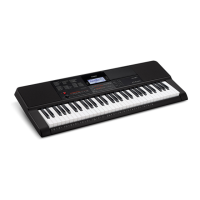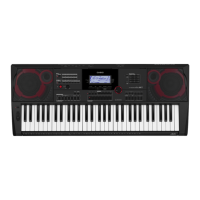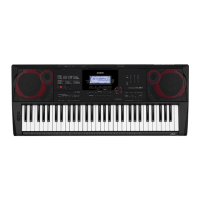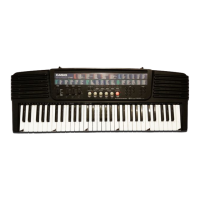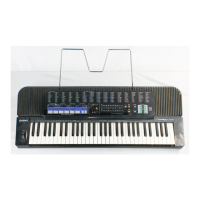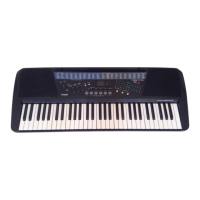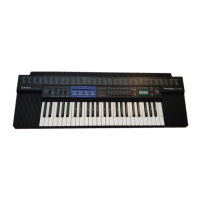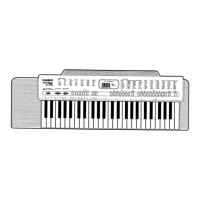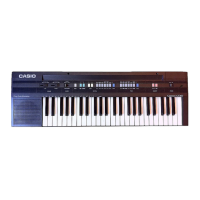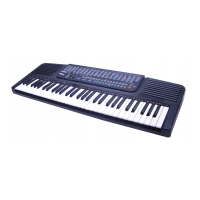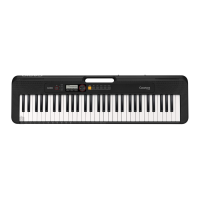EN-90
You can use the MIDI recorder for real-time recording of your
Digital Keyboard play.
• You can record up to 10 songs in Digital Keyboard memory.
Recorded content is saved in Song Bank song numbers 31
to 40 (user songs).
• One song can have up to 999 measures, or a total of
approximately 40,000 notes in all of its tracks. Recording
stops automatically when either of these limits is reached.
• You can play along with a recorded song on the keyboard.
• CASIO COMPUTER CO., LTD. takes no responsibility
for any damages, lost profits, or claims by third parties
arising from the deletion of recorded data due to
malfunction, repair, or for any other reason.
■ MIDI Recorder
Keyboard performance information is recorded as MIDI data*
to a system track or 16 solo tracks (storage areas for
keyboard performance data) in Digital Keyboard memory.
• Keyboard performance information (keyboard keys press/
release, touch pressure, etc.) is recorded as MIDI data.
• The size of MIDI data is much smaller when compared with
audio data, making it easier to edit later on a computer, etc.
• The MIDI recorder sounds the Digital Keyboard’s sound
source based on recorded MIDI data.
* MIDI
MIDI is short for “Musical Instrument Digital Interface”. It is a
universal standard that makes it possible for musical
instruments, computers, and other devices to exchange
performance information (keyboard key press/release, touch
pressure, etc.) regardless of manufacturer. Performance data
in this case is called “MIDI data”.
■ Recording Track and Recorded Data
● System Track
Records operations of the various different performance
functions of the Digital Keyboard, including Auto
Accompaniment, phrase pads, layer, split, etc.
● Solo Tracks 1 to 16
Record keyboard play using one tone (UPPER 1).
These tracks can be overdubbed as shown below.
The data recorded to each track is shown below.
■ Saving to an External Device
Songs recorded with the MIDI recorder can be saved to a
USB flash drive or a computer. For details, see “To save
Digital Keyboard data to a USB flash drive” (page EN-121)
and “Transferring Data Between the Digital Keyboard and a
Computer” (page EN-125).
Using the MIDI Recorder to
Record
System Recording Recorded Recorded
Solo 1 Empty
Recording Recorded
Solo 2 Empty Empty
Recorded
…
…
…
…
Solo 16 Empty Empty Recording
This type
of track:
Records this:
System
Track
Keyboard play, tone number (UPPER 1,
UPPER 2, LOWER 1, LOWER 2), rhythm
number, tempo, time signature, rhythm
controller operations, chord specification,
phrase pad operations, Auto Accompaniment
volume, effect settings (reverb, chorus, delay),
layer, split, auto harmonize/arpeggiator play,
scale settings (preset scale type and root,
scale fine tune, Auto Accompaniment scale
on/off setting), part fine tune, part coarse tune,
octave shift setting, pedal operations, pitch
bend wheel operations, bend range setting,
mixer settings, PORTAMENT button
operations, SUSTAIN button operations
CT-X5000: MODULATION/ASSIGNABLE
button operations (vibrato, DSP parameter
setting)
Solo Tracks Keyboard play, tone number (UPPER 1),
arpeggiator play, octave shift setting, pedal
operations, pitch bend wheel operations, bend
range setting, part fine tune, part coarse tune,
mixer settings, PORTAMENT button
operations, SUSTAIN button operations
CT-X5000: MODULATION/ASSIGNABLE
button operations (vibrato, DSP parameter
setting)
CTX5000_3000_EN.book 90 ページ 2018年2月26日 月曜日 午後3時56分
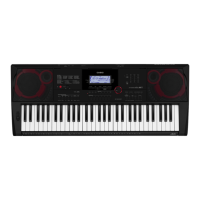
